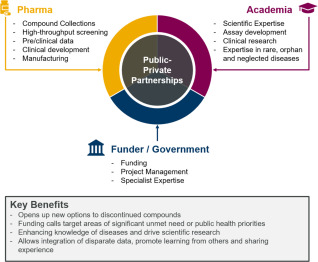Collaborative efforts between public and private entities such as academic institutions, governments, and pharmaceutical companies form an integral part of scientific research, and notable instances of such initiatives have been created within the life science community. Several examples of alliances exist with the broad goal of collaborating toward scientific advancement and improved public welfare. Such collaborations can be essential in catalyzing breaking areas of science within high-risk or global public health strategies that may have otherwise not progressed. A common term used to describe these alliances is public-private partnership (PPP). This review discusses different aspects of such partnerships in drug discovery/development and provides example applications as well as successful case studies. Specific areas that are covered include PPPs for sharing compounds at various phases of the drug discovery process—from compound collections for hit identification to sharing clinical candidates. Instances of PPPs to support better data integration and build better machine learning models are also discussed. The review also provides examples of PPPs that address the gap in knowledge or resources among involved parties and advance drug discovery, especially in disease areas with unfulfilled and/or social needs, like neurological disorders, cancer, and neglected and rare diseases.
This chapter advances the UN SDG Goal 3: Good Health and Goal 10: Reduced Inequalities by elucidating nutrition as a fundamental domain of global health. It highlights the health of individuals and the stability of populations within the academic discipline of global health.
This chapter advances the UN SDG Goal 3: Good Health and Goal 10: Reduced Inequalities by bringing attention to the urgent need for high-quality mental health services and psychosocial support in crisis areas.
Elsevier,
Heterogeneous Contributions to Numerical Cognition Learning and Education in Mathematical Cognition 2021, Pages 327-357
This book chapter advances SDG4 Quality Education and SDG 10 Reducing Inequalities by examining potential predictors for arithmetic abilities of children with and without AD.
In this episode of the “World We Want” podcast series, RELX’s Global Head of Corporate Responsibility, Dr. Márcia Balisciano, talks to Tessy Antony de Nassau about leadership.
This book chapter advances SDG 7 by explaining how actuators at oil and gas locations contribute to emissions and describes flow charts for proper actuator selection including utilizing electric actuators to help environmental impact.
This book chapter advances SDG 14 by explaining how biological factors that influence microbial structure and activity in coastal sediments include the various interactions between microorganisms involving trophic interactions such as competition, predation, and parasitism; between microbes and plants as well as the influence of benthic animals in the sediments.
This chapter advances the UN SDG goals 3 and 5 by providing an overview of common fungal infections of the mammary gland, which have consequences for mothers and babies.
Elsevier,
Assessments, Treatments and Modeling in Aging and Neurological Disease, May 2021, Pages 115-126
This book chapter advances SDGs 3 and 17 by summarizing the relation between AD, dementia and vascular disease.
Elsevier,
Preparing a Workforce for the New Blue Economy, People, Products and Policies, 2021, Pages 3-16
This book chapter advances SDGs 9, 13, and 15 by explaining how the blue economy of the future will be heavily dependent on national investments in ocean sciences, ocean-related technologies, and intelligent national policy creation about the national interest in the world ocean.

